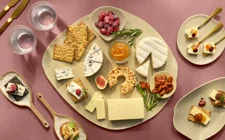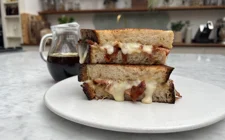
Chèvre
What is Chèvre?
Covering a wide range of cheeses, Chèvre, or fromage de chévre, describes a proud and bold approach to making artisanal French goats’ cheese - one that has remained committed to tradition for generations. Enjoyed in its fresh variants, it is intense and earthy, with a tangy kick to finish. The texture offers a firm and slightly soft density, with some having a creamy and spreadable consistency. As the cheese ages, the tart aromas and flavors sharpen, becoming increasingly dry and complex. Similarly, the rind hardens, with the interior growing crumbly and dense.
Originally produced in and around the central regions of France, traditional Chèvre is heavily influenced by the climate and pastures on which the goats graze. Depending on its characteristics, a region might invoke flavors suited for white mold cheeses, while others produce milk best enjoyed fresh.
Pair the tart flavors of fresh Chèvre with honey, ripe pear and roasted walnuts.
How Chèvre is made
Like fine wine, the process of making traditional Chèvre is based on an idea of constantly promoting the raw flavors of the milk. Artisans rely on experience and the natural quality of the milk, ensuring excellence throughout the cheeses.
A blend of cultures and rennet are added to raw or pasteurized milk in large vats, helping the milk coagulate and form a dense curd. Once the curd has solidified, it is separated and drained of whey. Workers then ladle the broken curd into special molds, allowing the cheese to rest and breathe. During this process, any remaining whey is strained naturally with the help of a generous coating of salt. This brining enhances the flavor and prevents the growth of any unwanted bacteria. In the case of fresh cheese, virtually no aging is needed, while on the other hand some aged variants require up to 12 weeks of maturation before they are fully developed.
True to the principles of craftsmanship and ingredients, traditional French Chèvre contains no artificial fillers or additives – nor do artificial preservatives ever find their way into the production process. This ensures a gluten-free cheese of the highest quality every time. With the use of calf rennet, however, most Chèvre is not suitable for vegetarians.
Curious about the world of cheese? Here's everything you need to know about how to store, serve and cut cheese!







